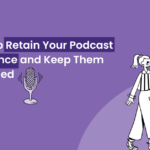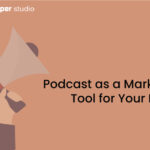Imagine your podcast featured on listening apps like Spotify, Apple Podcasts, and Stitcher. There’s nothing like getting your show featured by a popular podcast listening app.
You get to show off your podcast in the most coveted space, among prominent shows from major networks & publishers.
It’s an effective way to attract thousands of potential listeners, something that’d otherwise take you months. This is how many podcast listeners discover their new favorite shows, making it a sure way for creators to grow their audience.
To get your show up among those big podcasts, you’ll have to submit a pitch.
Most streaming platforms have a dedicated team of editors who carefully review all the pitches. It’s easy to get lost in the sea of other applicants with an already growing audience trying to bag that spot, so it’s important that your pitch comes out compelling, precise, and succinct.
Understand what they need
Most platforms accept submissions through forms that list the eligibility criteria and requirements. Make sure to go through these carefully and prepare yourself well before applying.
For instance, some platforms ask for a minimum audience size or a certain number of episodes published. In case you don’t meet these conditions, you might want to wait until you do.
In the submission form, you may have to provide the podcast artwork if you are looking at getting featured on a banner or a carousel.
So read the form carefully before submission and make sure you have everything you need.
Make your pitch compelling & relevant
If you are going to tell the editors how great your podcast is, then hold back. The question is not how good your podcast is but rather how it fits the featured spot you are applying for, how it is relevant, and why it would be engaging to the listeners.
This is where you provide context on what your podcast is about and how it stands out from the rest of the shows. Focus on what’s notable about your podcast – it could be the guests, the purpose of the show, or the timely theme.
For instance, if you are submitting a cricket podcast during the IPL season, then it’s wise to highlight the relevancy.
Even if you don’t have a podcast related to any tropical event, you can emphasize the core of your podcast that makes it different from other shows.
Where and how to pitch your show to get your podcast featured on listening apps
Apple Podcasts
Apple Podcasts is definitely the first place you’d want to start with. The platform has set a gold standard for both podcasters and listeners, so the shows featured in their curated sections surely see audience growth.
You can submit your podcast through the Apple Podcast Promotion Request form. You’ll be asked to fill in the basic details of your show, how you plan on marketing it, artwork, and more.
When laying out your marketing plan, make sure to use these pro tips – tag @ApplePodcasts, use your Apple Podcasts URL and use the official “Listen on Apple Podcasts” badges.
As for the artwork, use Adobe Photoshop to design your marketing creatives, as Apple currently only accepts Layered PSD files. Here are all the artwork guidelines and templates.
As great as it is to get featured on Apple Podcasts, it is equally hard to earn a spot there, so grab all the material, plead your case, and tell them why your podcast deserves to be featured on Apple Podcasts.
Stitcher
Stitcher features podcast shows across different avenues. From in-app advertising to getting featured in their weekly and monthly newsletters, you have more than one spot to try your hand at.
To apply, head to this link and fill out their Airtable submission form. You’ll be asked to provide your podcast metrics like download numbers, release frequency and host/cast diversity. The most significant field you’ll be asked to fill is the “why should this be featured?” field, where you will have to pitch your podcast.
Different categories will have different requirements. For some, you might have to supply custom graphics or soundbytes for featured spaces. You might also be asked to provide marketing materials. For more details, you can check out the official Stitcher help page.
Castbox
The process of getting featured on Castbox is a little different than others. The platform doesn’t have an algorithm you can crack or a form you can fill out. Instead, Castbox specifies four requirements that must be met before your podcast show is considered and they are:
- Your podcast should be on Castbox. You can submit to the platform here.
- Claim ownership. You can find the associated user account ID in the app Personal – your profile. Fill out the field “Claimed Account ID” in the form.
- Social media mentions
- Your podcast’s Twitter bio must tag Castbox. For instance, Listen on @Castbox_fm or Subscribe: [your Castbox link]. If your show doesn’t have a Twitter account, you can tag Castbox in your personal account.
- Share your Castbox channel on Twitter and tag @Castbox_fm. Copy the tweet link and put it in the field “Tweet Link” in the form.
- Include a Castbox badge and embedded player on your official website. In the form, add the podcast link and Castbox badge/embedded player in the field “Website URL.”
Once those requirements are met, your podcast can get features in two categories: banner promotions and Editor’s picks. Check out all the details here.
Amazon Music
Before you pitch your request to Amazon Music, make sure you are listed on the platform. If not, check out how to distribute our podcast to Amazon Music.
Next, you should actively promote the platform. You can start by adding the Amazon Music button to your podcast site. Include @AmazonMusic and the #PodcastsOnAmazonMusic when posting on social media so they can see you’re actively promoting.
Once you have the above two things sorted, you can submit your pitch to podcastpromo@amazon.com.
If your podcast is new, provide them at least two weeks of notice prior to launching your show. Here are all the details you must include in your email:
- Your podcast host name (Hubhopper, Captivate, Anchor, etc.)
- Contact name
- Podcast name and description
- Territory you want to promote it (Worldwide, US, UK, your home country)
- Trailer release date
- First episode release date
- Release schedule (daily, weekly, etc.)
- When you want them to start the promotion (mention date)
- How many downloads you are expecting
- Social media accounts used to promote shows and how will you promote Amazon Music in the process
- Podcasts’ original working files (i.e., layered PSD file) and host headshot(s) (if applicable)
Pocket Casts
To get a featured spot for your podcast show on Pocket Casts, you can send your pitch to curation@pocketcasts.com.
Pocket Casts is mostly looking to feature new and emerging podcasts or shows making a comeback with a new season. If your podcast falls in any of these categories, you have better chances of getting featured.
Some points to consider before sending out your request:
- Your podcast must have at least 1-2 episodes. If you haven’t launched yet, you can share an advanced notice but the platform doesn’t pre-promote shows.
- Share your podcast’s Pocket Casts link. If your podcast is not submitted to Pocket Casts, you can do it here.
- Your podcast must have a proper name, description, artwork and a well-formed feed.
Spotify
Spotify heavily depends on curated lists to recommend podcasts and music to its users. According to their help page, you can pitch your podcast to their editorial team using this form. The team is made up of podcast curation experts, programmers and editors, who listen to hours of content every week to select the shows and episodes that go in the playlists.
The team finds podcasts through various sources, including podcaster pitches, newsletters about podcasting, social media, networks & studios they follow, recommendations from their Content Partnerships team, word of mouth, and searching around the Spotify app itself.
Here are some factors that the team considers in a podcast:
- Experimental in format (e.g., fiction, music, comedy) with an element that keeps the listeners hooked
- Consistent across theme and production value
- Packed with plot twists & unexpected hooks (e.g., true crime, documentary)
- Personality-driven with incredible host chemistry (e.g., interview format)
- Thoroughly researched with a range of voices (e.g., news, science, history)
You can check out all their requirements here. The team also considers audio quality, but that shouldn’t deter creators who don’t have advanced setups. Isabella Way, Podcast Programming Lead at Spotify, says you don’t need a professional studio to create a good quality podcast; just ensure that the show provides a good listening experience.
Besides pitching, you can also actively market and promote your podcast. Spread the word about your podcast show on social media and tag @SpotifyPodcasts on Twitter, Instagram, and @Spotify on TikTok. Also, make sure you title your episodes in a consistent manner and spend time on your episode descriptions.





